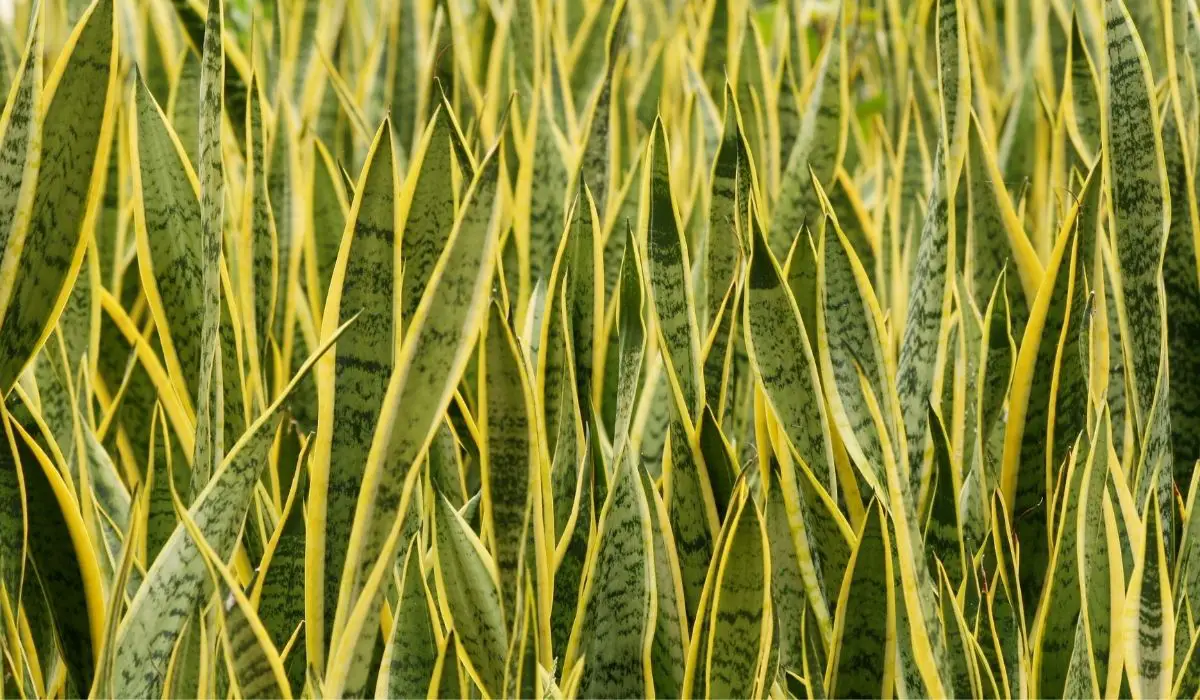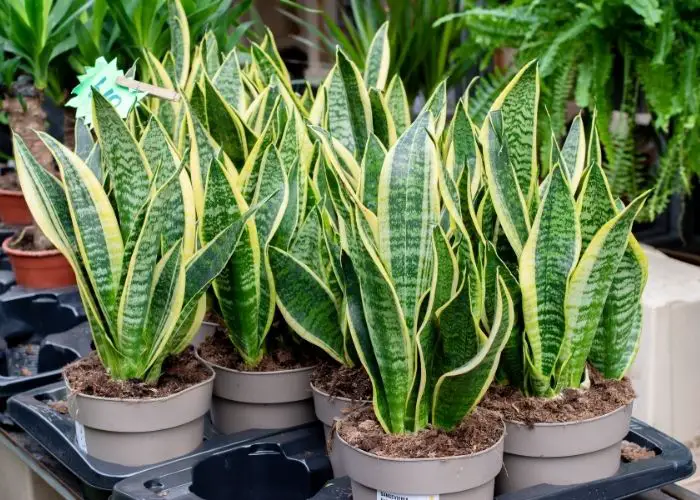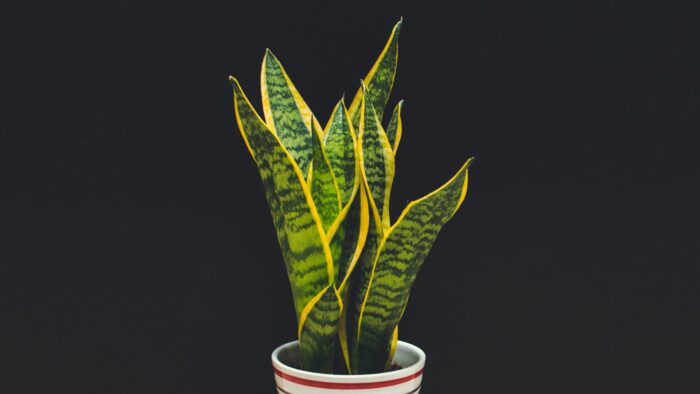Last Updated on March 8, 2023 by Griselda M.
There are several causes of snake plant mushy leaves that you should look out for. Wet gooey leaves are also a common problem most gardeners encounter when growing a snake plant both indoors and outdoors.
Snake plants (Sansevieria) are hardy green plants that most gardeners love to grow. However, these plants are quite sensitive to soil moisture which mainly kills them by causing root rot. Overwatering your snake plant can cause its leaves to turn yellow, droop, or become mushy and have other problems.
This guide will help you know when your snake plant is overwatered and how to prevent it from dying, which is caused by waterlogging. Taking note of the 5 critical signs that cause snake plant leaves to become mushy will allow you to deal with the problem promptly.
Causes of Snake Plant Mushy Leaves
Understanding the causes of snake plant mushy leaves is essential to keep it in good health. Overwatering is the primary cause of mushy leaves in snake plants. An overwatered plant shows signs that include drooping foliage and plant leaves turning yellow and falling over easily. If you notice snake plants with mushy leaves and rotting roots, save your plant by –
- Removing the plant from its pot and cutting off any rotting roots
- Re-potting it using a fresh potting mix to save the snake plant from dying
- Placing your newly re-potted plant where it receives bright indirect light.
Signs of Overwatered Snake Plants
It is easy to tell your snake plant is waterlogged simply by looking at the leaves. An overwatered snake plant’s leaves usually appear mushy, limp, and squishy. You may also notice that they occasionally tend to fall over. If you are unsure about the soil moisture levels, you can test it for wetness by pushing your finger into the topsoil to check for excess water.
Here are more signs to watch out for if you suspect you have overwatered your snake plant.
Soft, mushy, or squishy leaves or snake plant soggy leaves
When you feed your snake plant excess water, substantial damage happens to the leaf cell structure. Due to this excessive water intake, the leaves eventually burst. These leaves end up inheriting the popular snake plant mushy leaves problems – they become soggy, mushy, and squishy.
A healthy snake plant has firm green leaves standing upright from its plant’s base. The leaves act as water storage surfaces holding moisture absorbed from the soil within the inner surface of them.
Smelly soil and rotting roots
Root rot is a fungus and bacterial infestation considered dangerous to snake plants. The most common cause of root rot is overwatering -the soil stays in a damp state over extended periods. Wet soils provide an appropriate environment for bacteria, fungi, and worms that destroy the roots of the plant, causing them to wilt and eventually dry out.
You can easily tell if your plant is suffering from root rot by smelling your plant’s soil. Grab a smidgen of soil in the palm of your hands and bring it up to your nostrils to determine what it smells like. A smelly soil sample shows a sign of fungi, resulting from dampness. When you notice this type of smelly soil, check the anke plant roots for further signs of rot.
A healthy snake plant has crusty white roots. If you notice sections of the roots turning black or brown, it could also mean that your plant is suffering from rotted roots. In this case, it’s recommended that you remove the affected roots, wash the plant with clean water, and transplant it to a new potting medium.
Drooping leaves
Drooping leaves are a sure indication that your plant has a problem. However, the main reason for drooping leaves is most commonly too much water. However, underwatering and nutrient deficiency are also causes of your drooping leaves.
If you notice your snake plant’s mushy leaves starting to droop, check to see if:
- You have wet soil, which is proof that your plants are overwatered, leading to drooping leaves.
- The soil is too dry, meaning your plant is suffering from stress, poor temperatures, or underwatering.
- Drooping snake plants can also mean your plant has root rot, so you might need to check the roots and treat them accordingly.
Your snake plant falling over
It is okay for 1 or 2 leaves of your snake plant to fall over. However, if you notice this happening with a large number of leaves within a short period, it could be a sign that you are overwatering your snake plant.
Snake plants store water in their leaves; any excess intake triggers stress to the base of the leaves, causing them to fall over. Snake plant mushy leaves will cause the plant to fall over due to their heavy weight.
Leaves turning yellow
Healthy snake plant leaves are green with variations from different species and varieties. Yellowing of the leaves is a sign of poor health caused by inadequate sunlight, overwatering, environmental stress, excess fertilizer, etc.
In overwatering cases, leaves turn yellow because the roots are suffocating and unable to absorb nutrients that keep the snake plant healthy.
How Do You Save a Mushy Snake Plant?
The most significant way to save your snake plant’s mushy leaves is by changing the watering cycle and reducing the amount of moisture the plant receives each week. Therefore, you should stop watering your plant until the soil dries out completely.
- Move your snake plant to a sunny spot: to help it lose as much water as it can. However, avoid exposing it to excess sunlight for too long as this can worsen its stress.
- Remove your plant from the pot and repot it: Be gentle with your mushy snake plant as you lift it out. Loosen the soil to make it easy to remove the plant from the pot. Gently pull your snake plant from the pot to expose the roots. Use a new potting mix that is well-draining and report the snake plant. To prevent more waterlogging problems, do not water it for the first few days after replanting.
Should I Cut Dead Snake Leaf Leaves?
If you have noticed brown tips on your snake plant, it is a sign that your plant is facing some stress in its growth journey. These brown spots are actually dead areas of the plant, and cutting them off won’t hurt it.
Use a thin knife to cut the dead leaves away; however, be careful not to damage the healthy ones while at it. Remove all the old leaves and others that may be affected. The younger leaves will continue to grow and preserve the look of your plant.
How Do I Know If My Snake Plant is Rotting?
You can tell if your snake plant’s roots are rotting by observing the leaves’ general health. The leaves could be wilting or drying up due to an imbalance between the plant’s food supply and the leaves’ nutrient requirements. If left unchecked, root rot will stress your plant’s health to the point of eventually killing it.
Snake Plant Leaves Gooey
Seeing your snake plant leaves gooey can be a dreadful sight if left unattended. Aside from that, snake plants and their soggy spots are a cause for concern as it is a clear sign of something amiss. Although these succulents are low maintenance and can adapt to different environments easily, they do need care from time to time. There are several causes of snake plant mushy leaves, which include over or underwatering, root rot, and several others.
The result of inconsistent watering schedules can cause your snake plants to produce brown tips and soggy fronds, which are an eyesore. If you notice that the snake plant leaves have become gooey and are tipping over, this could indicate an almost definite deterioration of their root system. In this case, the rotted parts of the roots should be trimmed off immediately to allow your plant to grow back to its former glory.
However, if root rot is not present, but your plant has mushy leaves, the next best thing to do would be to reduce the amount of water that you usually feed it. Trimming off any brown tips at this time is also advised to reduce further damage to your beautiful snake plant. Additionally, snake plants can become pest infested and should be treated quickly to stop their progression. Therefore, it is advised to apply a thin layer of neem oil to your plant leaves to keep insects and other plant pests at bay.
Snake Plant Wet Leaves
Snake plant wet leaves are a common problem that is mainly caused by negligence. By this, I mean that these plants are often left to fend for themselves because they are known for their hardiness. This is a huge mistake that most gardeners make, as although snake plants are tough, they need proper care and maintenance from time to time. This irregular gesture will aid you in growing healthy and happy snake plants that lend their extraordinary beauty to your home and garden.
We know that several causes of snake plants’ mushy leaves give them a wet look. When you notice this, you should do a thorough inspection of your overall plant to get to the bottom of what is causing the wet leaves. Once this is established, you can use the information below to revive your plant and get it back on a steady, healthy growth path.
What to do about snake plant wet leaves:
1. You should first test the plant soil and ensure that it is not retaining too much moisture. If it is, then stop watering and inspect your plant roots for rot.
2. Snake plant leaves can become prone to pest infestation and should be dealt with promptly to prevent the leaves from getting mushier. Using an organic pesticide or other natural solutions to wipe your snake plant leaves will be beneficial.
3. Although snake plant pruning is not a must, removing yellow, brown, or spotted leaves would be best if they have become wet. This will encourage new growth and help bring your plant back to its former glory.
4. Ensure that your plant is growing in a pot that has enough drainage holes to let any excess water out. This will prevent root rot.
5. Repotting a damaged snake plant after pruning is also recommended. Using a 50/50 mixture of peat moss and perlite is great for snake plants to thrive.
Snake Plant Falling Out of Soil
Have you ever seen a snake plant falling out of the soil? It actually looks like the plant has deteriorated much and is on its way out. However, this is not always the case, as in some cases, a healthy snake plant can also tip over. So, why does a snake plant fall out of the soil? If the snake plant leaves are healthy and lush, then the reason it fell out of the soil could be because the plant has become top-heavy.
This is because their thick, tall foliage is supported by a very shallow root system. Therefore, the snake plants’ unsteadiness is caused because of the extra mass that is carried above the soil. Hence your plant pot keeps toppling over. You will also notice how easily their roots are yanked out of the ground when they fall. Snake plants that have outgrown their containers should be repotted in larger planters. This will afford them ample support, and you wouldn’t have to worry about them falling over or becoming uprooted.
However, ensure that the new pot that you choose has drainage holes, as the more the soil, the longer the moisture will bask in it. So, to prevent root rot when transferring your plant, try planting it a little deeper into the pot than you usually would. This small gesture is very effective because having an inch or so of soil beneath the deepest roots will aid in healthy plant growth and avoid waterlogging.
Key Takeaways:
Snake plant mushy leaves are a vital sign that warns you about overwatering problems and sensitizes you to save your plant as fast as possible before it dies. For this reason, it is essential to always monitor your snake plant so that you can spot health issues from the get-go. Using the information in this article, you should now have a fair idea of the indicative signs of declining health when it comes to your snake plants.
How do you save a mushy snake plant?
The easiest way to save your snake plant mushy leaves and plant is by changing the watering cycle and reducing the amount of water the plant receives each week. Stop watering your plant until the soil dries out completely.
Move your snake plant to a sunny spot. Move your plant to a sunny spot to help it lose as much water as it can. However, avoid exposing it to excess sunlight for too long as this can worsen its stress.
Remove your plant from the pot and repot it. Be gentle with your mushy plant as you lift it out of the pot. Loosen the soil to make it easy to remove the plant from the pot. Gently pull your snake plant from the pot to expose the roots with the soil loose enough. Use a new potting mix that is well-draining and replant the snake plant. To prevent more waterlogging problems, do not water it for the first few days of replanting.
Should I cut dead snake leaf leaves?
If you notice brown tips on your snake plant, it shows that your plant is facing some stress in its growth journey. These brown spots are actually dead areas of the plant, and cutting them off won’t hurt it.
Use a thin knife to cut the dead leaves away; however, be careful not to damage the other leaves. Remove all the old leaves and others that you think are too tall. The younger leaves will continue to grow and preserve the look of your plant.
How do I know if my snake plant is rotting?
You can tell if your plant’s roots are rotting by observing the leaves general health. The leaves could be wilting or drying up due to an imbalance between the plant’s food supply and the leaves’ nutrient requirement. If left unchecked, root rot will stress your plant’s health to the point of death.
Caroline is a gardener who loves to get down to the nitty–gritty of gardening. She proudly proclaims herself as a ‘dirt worshipper‘ and can often be found deep in the garden, covered in soil and singing to her plants. As a self–proclaimed ‘plant whisperer‘, Caroline believes that plants need love and attention just like any other living thing, and she loves to give them both. When she‘s not tending to her garden, you can often find her researching the latest gardening trends, or teaching others how to make their gardens thrive





